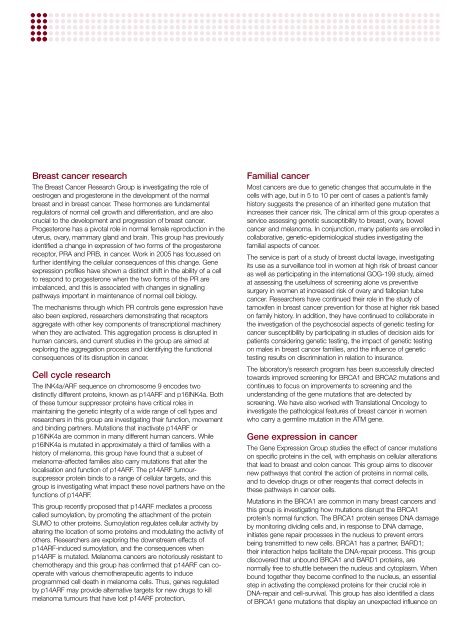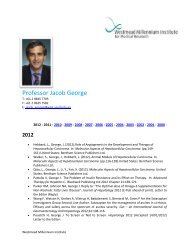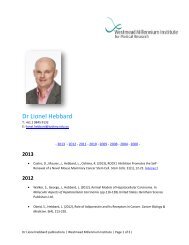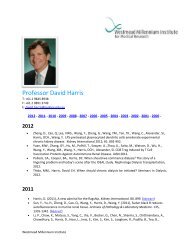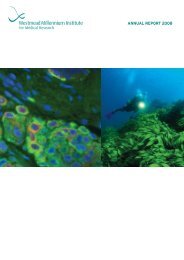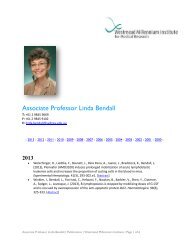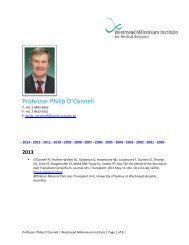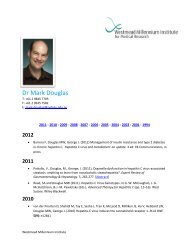Annual Report 2005 - Westmead Millennium Institute
Annual Report 2005 - Westmead Millennium Institute
Annual Report 2005 - Westmead Millennium Institute
You also want an ePaper? Increase the reach of your titles
YUMPU automatically turns print PDFs into web optimized ePapers that Google loves.
Breast cancer research<br />
The Breast Cancer Research Group is investigating the role of<br />
oestrogen and progesterone in the development of the normal<br />
breast and in breast cancer. These hormones are fundamental<br />
regulators of normal cell growth and differentiation, and are also<br />
crucial to the development and progression of breast cancer.<br />
Progesterone has a pivotal role in normal female reproduction in the<br />
uterus, ovary, mammary gland and brain. This group has previously<br />
identified a change in expression of two forms of the progesterone<br />
receptor, PRA and PRB, in cancer. Work in <strong>2005</strong> has focussed on<br />
further identifying the cellular consequences of this change. Gene<br />
expression profiles have shown a distinct shift in the ability of a cell<br />
to respond to progesterone when the two forms of the PR are<br />
imbalanced, and this is associated with changes in signalling<br />
pathways important in maintenance of normal cell biology.<br />
The mechanisms through which PR controls gene expression have<br />
also been explored, researchers demonstrating that receptors<br />
aggregate with other key components of transcriptional machinery<br />
when they are activated. This aggregation process is disrupted in<br />
human cancers, and current studies in the group are aimed at<br />
exploring the aggregation process and identifying the functional<br />
consequences of its disruption in cancer.<br />
Cell cycle research<br />
The INK4a/ARF sequence on chromosome 9 encodes two<br />
distinctly different proteins, known as p14ARF and p16INK4a. Both<br />
of these tumour suppressor proteins have critical roles in<br />
maintaining the genetic integrity of a wide range of cell types and<br />
researchers in this group are investigating their function, movement<br />
and binding partners. Mutations that inactivate p14ARF or<br />
p16INK4a are common in many different human cancers. While<br />
p16INK4a is mutated in approximately a third of families with a<br />
history of melanoma, this group have found that a subset of<br />
melanoma-affected families also carry mutations that alter the<br />
localisation and function of p14ARF. The p14ARF tumoursuppressor<br />
protein binds to a range of cellular targets, and this<br />
group is investigating what impact these novel partners have on the<br />
functions of p14ARF.<br />
This group recently proposed that p14ARF mediates a process<br />
called sumoylation, by promoting the attachment of the protein<br />
SUMO to other proteins. Sumoylation regulates cellular activity by<br />
altering the location of some proteins and modulating the activity of<br />
others. Researchers are exploring the downstream effects of<br />
p14ARF-induced sumoylation, and the consequences when<br />
p14ARF is mutated. Melanoma cancers are notoriously resistant to<br />
chemotherapy and this group has confirmed that p14ARF can cooperate<br />
with various chemotherapeutic agents to induce<br />
programmed cell death in melanoma cells. Thus, genes regulated<br />
by p14ARF may provide alternative targets for new drugs to kill<br />
melanoma tumours that have lost p14ARF protection.<br />
Familial cancer<br />
Most cancers are due to genetic changes that accumulate in the<br />
cells with age, but in 5 to 10 per cent of cases a patient’s family<br />
history suggests the presence of an inherited gene mutation that<br />
increases their cancer risk. The clinical arm of this group operates a<br />
service assessing genetic susceptibility to breast, ovary, bowel<br />
cancer and melanoma. In conjunction, many patients are enrolled in<br />
collaborative, genetic-epidemiological studies investigating the<br />
familial aspects of cancer.<br />
The service is part of a study of breast ductal lavage, investigating<br />
its use as a surveillance tool in women at high risk of breast cancer<br />
as well as participating in the international GOG-199 study, aimed<br />
at assessing the usefulness of screening alone vs preventive<br />
surgery in women at increased risk of ovary and fallopian tube<br />
cancer. Researchers have continued their role in the study of<br />
tamoxifen in breast cancer prevention for those at higher risk based<br />
on family history. In addition, they have continued to collaborate in<br />
the investigation of the psychosocial aspects of genetic testing for<br />
cancer susceptibility by participating in studies of decision aids for<br />
patients considering genetic testing, the impact of genetic testing<br />
on males in breast cancer families, and the influence of genetic<br />
testing results on discrimination in relation to insurance.<br />
The laboratory’s research program has been successfully directed<br />
towards improved screening for BRCA1 and BRCA2 mutations and<br />
continues to focus on improvements to screening and the<br />
understanding of the gene mutations that are detected by<br />
screening. We have also worked with Translational Oncology to<br />
investigate the pathological features of breast cancer in women<br />
who carry a germline mutation in the ATM gene.<br />
Gene expression in cancer<br />
The Gene Expression Group studies the effect of cancer mutations<br />
on specific proteins in the cell, with emphasis on cellular alterations<br />
that lead to breast and colon cancer. This group aims to discover<br />
new pathways that control the action of proteins in normal cells,<br />
and to develop drugs or other reagents that correct defects in<br />
these pathways in cancer cells.<br />
Mutations in the BRCA1 are common in many breast cancers and<br />
this group is investigating how mutations disrupt the BRCA1<br />
protein’s normal function. The BRCA1 protein senses DNA damage<br />
by monitoring dividing cells and, in response to DNA damage,<br />
initiates gene repair processes in the nucleus to prevent errors<br />
being transmitted to new cells. BRCA1 has a partner, BARD1;<br />
their interaction helps facilitate the DNA-repair process. This group<br />
discovered that unbound BRCA1 and BARD1 proteins, are<br />
normally free to shuttle between the nucleus and cytoplasm. When<br />
bound together they become confined to the nucleus, an essential<br />
step in activating the complexed proteins for their crucial role in<br />
DNA-repair and cell-survival. This group has also identified a class<br />
of BRCA1 gene mutations that display an unexpected influence on


